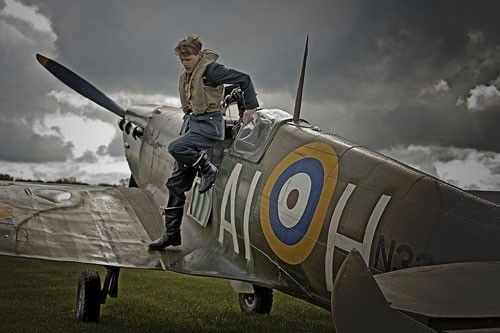
Spitfire MkII - "Vicky"
The Spitfire aircraft - famous for her beauty and “Britishness” - it is one of the world’s most iconic aircraft. The Spitfire design team was led by Reginald Mitchell, who sadly died in June 1937 - aged only 42. Mitchell never got to see his how his ground-breaking design changed the outcome of World War 2.
There were 24 different versions of Spitfire built – each version is referred to as a “mark”. Before you now - is our Mark Two Spitfire - fondly named “Vicky”. She was constructed in 2009 - and is an exact replica of the type that saw active service over Dunkirk and during the 1940 Battle of Britain.
Vicky made her screen debut - as part of the TV adaptation of “Spitfire Pilot” - Geoffrey Wellum’s wartime experience as the youngest serving fighter pilot during the Battle of Britain. During the filming of this drama series – named “First Light” - “Vicky” was painted in different colours and with a fictitious Squadron Code - A-I-H - as shown on the audio tour image on your device.
Today - Vicky is re-coded F-Y-N, to depict a 6-1-1 West Lancashire squadron aircraft. In 1940 - tail Number X-4-2-5-3 - was the mount of Sergeant Wilfred Duncan Smith - eventually chalking up six enemy aircraft kills - and becoming a well-known Spitfire Ace. Duncan Smith survived WW2 - and started a family; his son – Iain Duncan Smith - was later to become leader of the Conservative Party!
Vicky is painted in the typical earth and green camouflage markings - designed to blend perfectly with the British countryside below, making the Spitfire harder to see from the air. The underside – however - is white and black. These striking markings were adopted to more easily identify the aircraft to “friendly” allied forces who were fighting their way back to the beaches of Dunkirk in June 1940. The familiar black and white markings were adopted again - later on in WW2 - when allied aircraft returned to the French coast - on the 6th June 1944 - for the D-Day invasion.
You will notice Vickys propeller has just three blades – whereas - Lucy – our later Mark 9 Spitfire across the Hangar - has four. The additional propeller blades were needed to make full use of the increased engine power to increase speed. Later Spitfire versions had 5 propeller blades - this is an easy way to recognise the variant. Behind the propeller - sits the Rolls Royce Merlin engine – which gave her the distinctive roar. Through the war - Supermarine modified the Spitfire - to take on more and more combat roles – and to keep up with advancing German aircraft technology – so the engine became bigger and heavier. The Rolls Royce was eventually replaced with the Griffon engine.
Underneath the aircraft wing – is a Trolley Accumulator. This trolley contains a heavy battery pack - which was used to start the engine. After use – the trolley accumulator would be plugged in to the mains to recharge. Where this was inconvenient - or use was high – the trolley was fitted with a small generator – capable of charging the batteries directly.
Whilst talking about fuel challenges of the Merlin Engine, it is worthy of note that 85 gallons of high-octane fuel sat in the fuel tank - behind the engine - and just in front of the pilot’s control panel. It was not uncommon for the fuel tank - or radiator - to be holed during combat - with the fuel and coolant pouring back into the cockpit area. Sadly – due to this - many Pilots were badly burned - though some returned to the air as part of Guinea Pig Squadrons.
At the start of the Battle of Britain - new Pilots - many under the age of 21- could expect to receive as little as 10 hours training on the Spitfire or Hurricane - before being sent into combat. Luftwaffe pilots were generally a lot more experienced - having already flown in the Spanish Civil War and the Nazi invasions of Poland, Netherlands, Belgium and France.
Operation Sealion – the Nazi plan to invade Britain – could only be successful if the Luftwaffe could gain air supremacy over the English Channel – allowing the German Army – the Vehmacht – to cross without losses. In 1940 - 544 RAF Command Pilots - from across the Commonwealth and America – and 2500 Luftwaffe aircrew - died in combat during the Battle of Britain. The climax of the Battle was the 15th of September – where Germany mounted the largest attack – in terms of aircraft volumes - this is now recognised as Battle of Britain Day. After the unexpected and unprecedented losses of German aircraft – and failure to crush the RAF - and gain air supremacy - Adolf Hitler indefinitely postponed Operation Sealion - on the 17th September 1940. Britain was saved from invasion!
Vicky is now in a state of refurbishment, with many original Spitfire parts being restored, and to be eventually reinstalled into the cockpit for the public to view.
We hope you have enjoyed viewing our Mark 2 Spitfire. You are welcome to take photos before moving on.
-
Welcome to Strathearn Park!
-
Strathearn Park's Visitors Center
-
The Montgomery Playhouse
-
The Santa Susana Corner
-
The Original Saint Rose of Lima Church Building
-
The Strathearn House
-
The Strathearn Family
-
California State Historical Landmark #979
-
The Simi Adobe
-
The Colony Houses
-
The Haigh-Talley Colony House
-
The Printz-Powell Colony House
-
The Hirschi Monument
-
The Simi Library
-
The Pioneer Memory Garden
-
The Gazebo
-
History of the Wood Ranch Area
-
The Wood Ranch Barns
-
The Currier Apricot Pitting Shed
-
The Barbershop Building
-
The Simi Store